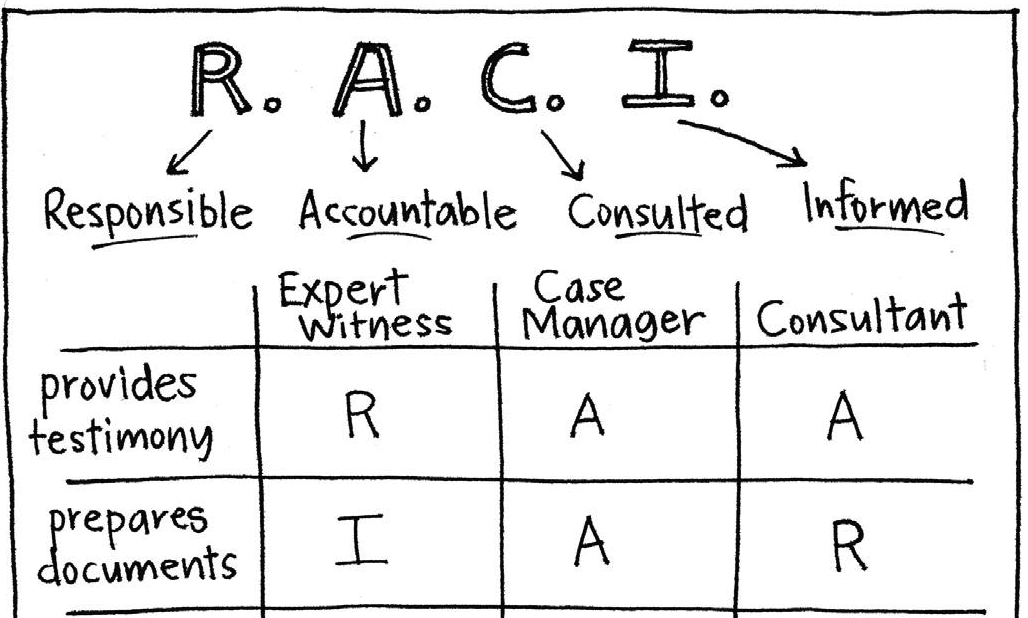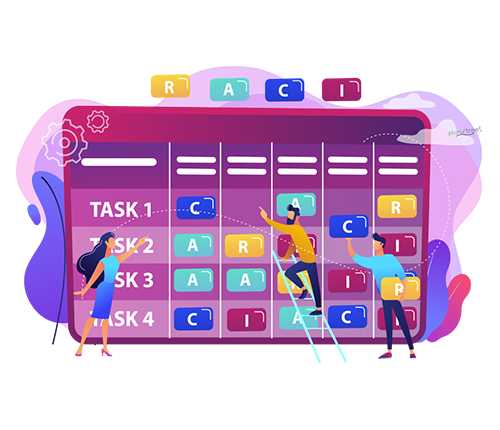
Last Updated on January 30, 2021 by Jacob
The following article has the purpose on explaining why we should use the RACI matrix to manage stakeholders.
Stakeholders are people and people make projects successful. If we do not manage our stakeholders correctly, or choose the wrong people as stakeholders, our project will fail.
There’s a saying: “Tell me who your friends are, and I will tell you, who you are.”
The same goes for projects:
“Tell me who the stakeholders are, and I will tell you if your project will be successful or not.”
Stakeholders are anyone who are gonna have a negative or positive influence on the project.
Why do Projects fail?
- Poor Scheduling
- Inaccurate Business Case
- Communication issues
- Unclear objectives to the team
- Compromising quality
- Ambiguous responsibility
- Inefficient estimation
- Management priorities
If you look at the above reasons, you will see that all parameters are directly connected to people.
The American non-profit Project Management Institute (PMI) has concluded that somewhere in the world $1M are wasted every 20 seconds in projects due to poor project management.
All waste is ultimately leading to human decisions, skills and priorities. PMI has categorised companies in a spectrum including “champions” and “underperformers”.
90 % of the “champions” are able to complete projects on time and within budget compared to the “underperformers” of which only 25 % on average are successful in terms of delivery within budget and time.
PMI found that the successful companies in average are 2-7 times more likely to priotize:
- Development of skills of executive sponsors
- Development of strategic and business management skills
- Development of technical skills
- Development of leadership skills
- Use of agile approach to projects
Requirements come from stakeholders. Taking an example of a software company developing software we can zoom out: First comes Strategy of the company. Within the company is a portfolio. Strategy and portfolio decides which products are going to be built. The product is then going to have multiple releases built by small iterations with a focus on a minimum viable product. All this information comes ultimately from stakeholders.
On top of technical specifications comes compliance with standards, regulations and integration needs. The actual information from stakeholders is rarely clear and definite, which makes projects much more complex. All this makes it necessary to have an efficient stakeholder management.
The RACI matrix explained

First of all stakeholders need to be identified, their level of involvement and at which stage they will be involved.
RACI = Responsible, accountable, Consulted, Informed:
- R – One or more people doing the work. Those who get the work done.
- A – Single person accountable for the outcome. Liable for the success/failure of the overall outcome.
- C – One or more giving expert guidance. People that guide but do not do the work.
- I – Groups of people requiring updates.
The responsible person/group are working in a direction set by the accountable. The difference between the responsible and the accountable is that the accountable (A) can also be responsible, but the responsible (R ) can never be accountable. Accountability can not be shared. Accountability can only be one person.
The consulted (C) are stakeholders who have the knowledge. Not just the technical knowledge, but also the strategic perspective, business dimension and people dimension.
The informed (I) are those who receive an output from a process, task or final project, or by other means needs to be informed. This can be management.
RACI is effective to monitor engagement in a project. A common saying among users of the RACI matrix is: “Who you know matters more than what you know”. By this saying that it is not just the knowledge of one stakeholder that matters, but knowledge of the complex network, in which they operate.
In addition to the RACI matrix it makes sense to make a stakeholder engagement assessment. The stakeholder journey can be defined as a 5 step journey:
- Unaware
- Resistant
- Neutral
- Supportive
- Leading
The different stakeholders must be at a different stage in the stakeholder journey for the project to be successful. Not all stakeholders need to be leading. For some Neutral is fine. This can be illustrated lige this:
| Stakeholder | Unaware | Resistant | Neutral | Supportive | Leading |
| Stakeholder 1 | Current | Desired | |||
| Stakeholder 2 | Current | Desired | |||
| Stakeholder 3 | C / D |
The gap between current and desired determines the required effort to engage a stakeholder. This part is where you really need to do your homework. Who needs to be engaged and to what extent?
The Responsible persons are the ones who get the work done, but the responsible persons cannot get the work done, if there are no accountable person and people to consult with consulting expertise.
Example of RACI – (software production)
| Activities | Sponsor | PM | Developer | Q/A |
| Funding | A | R | C | I |
| Planning | C | AR | R | R |
| Coding | I | A | R | I |
| Quality | C | A | R | R |
In this case the project manager is responsible for getting funding, but the sponsor is accountable. In the planning phase the Project manager is both responsible and accountable, while developer and Q/A are only responsible. This means the project manager actively participates in the planning – thus also responsible. Developers are doing the code, while PM stays accountable. The quality is done by Q/A team together with developers, but project manager remains accountable.
RACI errors:
- Blame game – too many cooks poison the food. It’s crucial that there is ultimately only ONE accountable for each task.
- Too many R’s – High task ambiguity or breakdown. Too many meetings leads to conflicts and lack of ownership to delivery. Lack of ownership will lead to everything falling apart.
- Too many A’s. Lack of leadership. Lack of commitment and too many power struggles.
- No R’s Inadequate resource management. Lack of engagement to outcome.
- No A’s : Too much Risk Exposure. Quality compromises. Lack of productivity.
Solution to project management blame game errors.
Address Responsibility problems
- Give Primary responsibility to one member (R1)
- Build commitment to delivery
- Incorporate Transition planning.
- Nothing is considered ready before it meets the DOD (Definition of done)
- Think succession planning (R2)
- Create backup capacity with another team member
Address accountability issues
- Are the accountable people capable? Do they have a Kaizen mentality and leadership skills?
- Do the have the right skills? Cross Functional thinking? Value delivery mindset?
- How competent are they? Do they have Operational excellence, process thinking and risk ownership?
Blame game solution – second step
- Do “R” owners have the required details to deliver?
- Do we know if “R” owners know the business impact of a non delivery?
- Are the “A” owners able to communicate at various levels in the organization?
- Do the “A” owners have a proper approach to risk management?
Additional tips to avoid the blame game:
- Incorporate and facilitate “System thinking” at both the people and process level.
- Develop communications skills in the organization to empower and enable people.
Typical stakeholder mentality errors:
- This is not in my job description
- This kind of job is not for me – not my cup of tea.
- I didn’t know what was expected of me.
- If only I was informed / had known ….
Typical symptoms of a dysfunctional RACI Matrix
Mixed Roles in the RACI matrix:
- R/A brings bias in decisions
- R/C believes some work is optional
- A/C leads to lack of commitment
Empty spaces in the RACI Matrix
- Too much JIT (Just in time) Planning
- No commitment to quality
- Bad Leadership
- Toxic culture
Too many C’s
- Ineffective leadership
- No task/skill alignment
- Lack of value in the project
- No focus for process. No clear processes.
Too many I’s
- Lack of team commitment – too many participants in meetings.
- Lack of innovation.
How to address Consulting issues.
- Make sure the right people do the right jobs.
- Don’t mix “expertise” with “getting work done”. The experts are not necessarily the best in getting the work done.
- Engage experts early in the project and listen to them actively.
- Mine for knowledge within the organization. FInd out who and how many experts you have on a given subject.
How to address Informed issues
- Understand the “I’s” requirements.
- Analyse and plan for RISK
Sum up: The typical RACI Failure patterns are:
- Too many A’s or no A’s
- Too many R’s or no R’s
- Mixed roles
- Empty cells (roles not assigned in RACI matrix)
- Lots of I’s
- Lots of C’s
